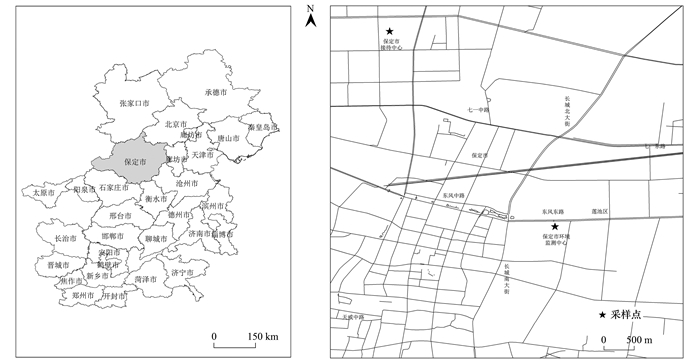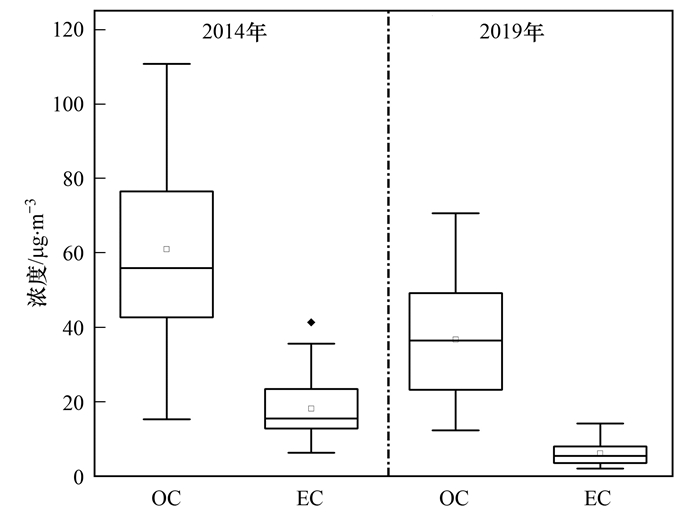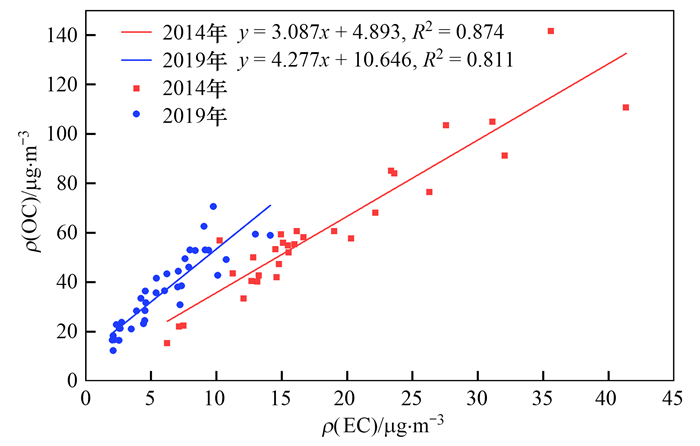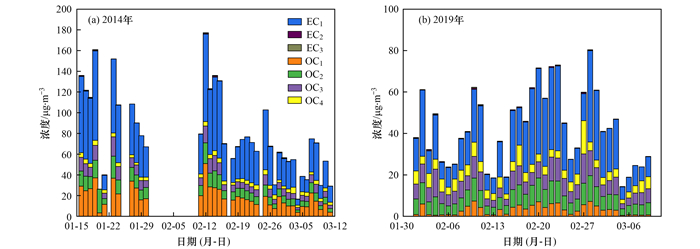2. 保定市生态环境监控中心, 保定 071000;
3. 保定市气象局, 保定 071000
2. Monitoring Center of Ecological Environment of Baoding, Baoding 071000, China;
3. Baoding Meteorological Bureau, Baoding 071000, China
随着中国经济、城市化和工业化的快速发展, 颗粒物(PM)污染已经成为影响空气污染的首要问题[1~3].碳组分是颗粒物的主要成分之一, 对大气能见度、全球气候变化[4]、空气质量和人类健康都有重要影响, 含碳物质较多的颗粒被认为比那些富含硫酸盐和硝酸盐的无机颗粒毒性更大[5, 6].碳质气溶胶的来源与燃料燃烧密切相关, 特别是机动车尾气排放和取暖燃煤排放[7], 有研究指出煤炭是中国碳质气溶胶排放的主要贡献者[8, 9], 煤炭燃烧产生的颗粒物中含有大量的碳质成分, 包括有机碳(OC)、元素碳(EC)和碳酸碳(CC)[10, 11], 其中OC和EC占PM2.5的质量分数为20% ~50%, 甚至可达到80%[12].OC包括污染源直接排放的一次有机碳(POC), 也包括经过二次生成的二次有机碳(SOC).EC主要来源于生物质或化石燃料的燃烧过程, 在大气中不容易发生化学反应, 所以也常常用作一次排放的示踪物来估算二次有机碳(SOC)的生成.根据已有的排放估计, 中国被认为是全球碳质气溶胶的最重要贡献者之一[9].
中国对碳质气溶胶的研究主要集中在珠三角[13]、长三角[14, 15]、川渝地区和京津冀[16~18]等城市, 总体来看京津冀地区含碳气溶胶浓度高于珠三角、长三角地区.京津冀地区是中国最发达的城市群之一, 大气颗粒物受到人为排放的影响很大[19].近年来, 京津冀地区燃煤和生物质燃烧对PM2.5的贡献逐渐降低[20], 但燃煤源依然是该地区PM2.5的主要来源之一, 其中保定市的燃煤源对PM2.5的贡献最高, 特别在秋冬采暖期PM2.5、OC和EC浓度较高[17].

|
图 1 “2+26”城市分布及采样点位置示意 Fig. 1 The "2+26" urban distribution and location of sampling sites |
保定市位于河北省西北部, 太行山东麓北部, 燕山山脉南侧, 冀中平原西部, 介于北纬38°10′~40°00′, 东经113°40′~116°20′之间, 紧邻北京市, 一直以来就面临严重的大气颗粒物污染问题.2013~2016年保定市空气质量综合指数排名一直位于全国重点城市的倒数5名以内, 2014年为京津冀及周边“2+26”城市(“2+26”城市)中排名倒数第一, 空气污染严重.2015年保定市开始实施多项大气污染治理措施, 空气质量开始持续好转[21], 其中治煤除燃煤小锅炉淘汰外, 清洁取暖(包括“气代煤、电代煤”、使用清洁煤、劣质散煤专项治理和集中供暖等)是最主要的措施.2019年保定市空气质量综合指数从2014年“2+26”城市中排名倒数第一提升为倒数第七, 在“2+26”城市中排名变化最大.
为了探究保定市“清洁取暖”措施对PM2.5中碳质气溶胶浓度和来源的影响, 本文利用2014年和2019年清洁取暖措施实施前、后保定市采暖期采样数据, 通过SOC估算、相关性分析和主成分分析法等方法, 对保定市PM2.5中碳质气溶胶质量浓度和来源变化进行研究.
1 材料与方法 1.1 样品采集2014年PM2.5采样点为河北省保定市环境监控中心, 采样时间为2014年1月20日至2014年3月11日; 2019年PM2.5采样点为保定市接待中心, 采样时间为2019年2月1日至2019年3月9日.保定市环境监控中心位于保定市莲池区东风东路, 保定市接待中心位于保定市竞秀区创业路(图 1), 采样点周边以居民区为主, 无明显工业源, 主要受当地生活排放源、交通源等影响. 2014年和2019年两个站点采样期间在线PM2.5浓度数据差异分别为3.39%和5.51%, 数据差异不大, 说明保定市主城区内PM2.5空间分布较为均匀, 因此选取这两个观测点可以代表保定市大气气溶胶污染状况[22].降雪、大风或仪器故障时停止采集样品, 2014年采集样品47个, 其中空白膜6张, 有效样品41个; 2019年采集样品43个, 其中空白膜5张, 有效样品37个.
采样设备为武汉天虹仪表责任有限公司生产的TH-16A四通道大气颗粒物智能采样仪, 4个通道采样流量分别为16.7 L·min-1, 其中两个通道分别采集直径为47 mm的Teflon膜和石英膜, 采样周期为23 h, 另外两个通道放备用膜, 定期更换.采样前对采样设备进行流量校准.采样期间, 每隔7 d采集一组空白膜样品.
1.2 膜处理与分析采样前石英膜预先置于马弗炉中, 500℃焙烧4h, 消除可能存在的有机物和杂质, 冷却至室温后放在温度为(20±1)℃、相对湿度为(50±5)%的恒温恒湿箱中平衡48h以上, 用十万分之一天平(0.01mg)称量3次后放入膜盒中保存.样品采集后用同一天平重复以上平衡和称量操作.
采用美国沙漠所研制的DRI Model 2001A热光碳分析仪分析样品中碳质气溶胶, 利用IMPROVE(interagency monitoring of protected visual environment)分析协议规定的热光反射法测定样品中OC(OC1、OC2、OC3、OC4)和EC(EC1、EC2、EC3)的浓度[23~26].
1.3 在线数据来源与气象评估方法环境空气质量监测数据来自中国环境监测总站发布的保定市2014、2017和2019年逐小时数据.气象数据来源于中国气象数据网发布的地面逐小时数据, 选取保定市气象站同期气温、风速和风向等资料.
为研究气象要素变化对保定市大气污染物浓度影响, 本文利用本课题组建立的城市尺度大气污染物输送扩散理论评估方法对保定市PM2.5浓度开展气象要素变化的评估.
2 结果与讨论 2.1 PM2.5、OC和EC浓度特征保定市2014年采暖期ρ(OC)和ρ(EC)分别为60.92 μg·m-3和18.15 μg·m-3, 2019年采暖期分别为36.63 μg·m-3和6.07 μg·m-3(图 2), 2017年采暖期ρ(OC)和ρ(EC)分别为57.12 μg·m-3和14.16 μg·m-3[23].与2014年采暖期相比, 2017年采暖期OC和EC分别下降6.24%和21.98%, 2019年采暖期OC和EC分别下降了39.87%和66.56%, 2019年采暖期相较于2017年采暖期分别下降35.87%和57.13%, 2017年和2019年相较于2014年EC下降的幅度都大于OC. EC主要来自一次污染物的排放, EC下降的幅度大于OC说明保定市来自一次排放源贡献下降[27].Fang等[28]研究发现燃煤是京津冀地区EC的主要来源(2012~2013全年平均贡献了50%), 因此保定市EC的下降幅度大于OC得益于燃煤源排放减少, 这与2015年以来保定市开始推行的清洁取暖政策, 取缔散煤和燃煤锅炉, 劣质散煤专项治理的时间线相一致[29, 30].2015年保定市启动清洁取暖工作, 主城区和各区县采取集中供暖方式, 农村地区则以“煤改气, 煤改电”(“双替代”)为主, 保定市主城区集中供热率由2014年的39%升至2017的100%, 各区县主城区平均达到80%以上.2015~2016年, 保定市完成190个村、8.7×104户清洁取暖工作, 2017年, 完成1 685个村, 74×104户, 截至到2019年6月底, 累计完成163.36×104户的清洁取暖工作, 共替代散烧煤237.03×104 t[27], 从2014年、2017年和2019年保定市采暖期大气中的碳质气溶胶观测数据可知, 2014~2019年一直呈下降趋势, 特别是从2017年后下降幅度显著增加, 这可能与保定市清洁取暖的范围和位置有关. 2015~2017年保定市清洁取暖范围主要是保定市主城区和北部区县, 2018~2019年保定市清洁取暖范围主要在保定市南部区县和农村, 到2019年底保定市全部完成清洁取暖工作, 2017~2019年间OC和EC下降幅度大于2014~2017年, 说明农村地区散烧煤的取代工作对OC和EC的减排贡献很大.

|
图 2 OC和EC浓度统计值 Fig. 2 Statistics of OC and EC concentrations |
已有研究表明保定市冬季来自正南方向短距离气团携带污染物浓度高于西北气团[31], 因此保定市南部区县清洁取暖对保定市空气质量改善影响高于北部区县, 在南部区县和农村地区进一步实施清洁取暖后, 保定市OC和EC浓度下降幅度进一步加大.保定市在开展清洁取暖工作的同时, 也实施了多项其它大气污染治理措施, 如从严治企、强力抑尘和严厉控车等, 但对PM2.5来源解析分析可知[27], 民用燃煤源的治理在保定市空气质量改善中起了最重要的作用.由此可以推知保定市2014~2019年冬季采暖期OC和EC浓度的下降与此期间实施的一系列大气污染治理措施有关, 特别是清洁取暖措施的实施对农村地区散煤的治理和能源结构的调整.
大气污染物浓度下降, 除了与人为减排的努力有关外, 与气象要素变化也密不可分.本文以2014年为基准年, 对2017年和2019年的气象要素进行评估, 用于分析后两年同期的气象要素变化对于PM2.5浓度下降的影响(表 1).相对2014年, 2017年ρ(PM2.5)下降了24.1μg·m-3, 其中2017年气象条件不利于污染物扩散, 使ρ(PM2.5)增加了1.5 μg·m-3, 与基准年相比增加0.92%, 大气污染物排放控制减排下降了25.6 μg·m-3, 与基准年相比下降15.69%. 2019年相对2014年, ρ(PM2.5)下降了61.8 μg·m-3, 其中2019年气象条件同样不利于污染物扩散, ρ(PM2.5)增加了9.4μg·m-3, 与基准年相比增加5.76%, 而减排下降了71.2 μg·m-3, 与基准年相比下降43.63%.保定市2017和2019年相对于2014气象条件更加不利于扩散, 保定市空气质量的改善为“人努力”的结果.
|
|
表 1 保定市2014、2017和2019年气象要素变化和污染物减排对PM2.5影响的评估结果1) Table 1 Evaluation results of the impact of changes in meteorological elements and pollutant emission reduction on PM2.5 in Baoding in 2014, 2017, and 2019 |
2.2 与京津冀其他城市的对比
北京市2016~2017年采暖期相较于2015~2016年采暖期OC上升了5.64%, EC下降了44.28%(表 2), 2017~2018年采暖期相较于2016~2017年采暖期OC下降了42.45%, EC下降了70.12% ~84.06%.北京市2015~2018年采暖期期间OC和EC均有不同程度下降, 其中EC下降幅度大于OC, 2015~2018年采暖期EC下降幅度超过70%, 有研究表明, 北京市出现污染时常伴有偏南风, 即受南部沿太行山污染物传输影响[32], 随着保定市北部九区县2015年清洁取暖工程实施到2017年的基本结束, 不仅保定市PM2.5中OC和EC下降, 北京市OC和EC也出现了非常明显的下降, 说明清洁取暖政策对降低PM2.5中OC和EC效果明显.天津市2017年采暖期相较于2014年采暖期OC和EC分别下降了19.02%和6.89%(表 2), 2018~2019年采暖期相较于2017年采暖期OC和EC上升了19.58%和18.85%.天津市2014、2017和2018~2019年采暖期间OC和EC在稳定水平上下波动.石家庄市2016~2017年采暖期OC相较于2013年下降了13.23%, 但EC上升了7.33%.
|
|
表 2 不同研究中OC和EC浓度/μg·m-3 Table 2 Concentrations of OC and EC in different studies/μg·m-3 |
“2+26城市”2019年采暖期OC较2017年采暖期下降了15.8%, 较2018年采暖期下降了29.4%, 2019年采暖期EC相较于2017年采暖期下降了3.0%, 较2018年采暖期下降了1.2%[33].“2+26”城市OC和EC在2017~2019年采暖期期间呈现下降趋势, 其中OC下降幅度大于EC.与天津市和石家庄市相比, 保定市OC和EC下降幅度大, 其原因与天津市和石家庄市大气颗粒物中OC和EC主要来源与保定市的不同有关, 天津市主要来源于汽油车尾气、道路扬尘、燃煤与生物质燃烧[34], 石家庄市主要来源于工业排放、机动车尾气、燃煤和二次有机碳等[35].保定市OC和EC下降幅度大于“2+26”城市, 且保定市EC下降幅度大于OC, “2+26”城市OC下降幅度大于EC, 由此可以进一步说明保定市来自煤炭和生物质燃烧的一次排放的减少, 这与相关研究者2015~2019年在南京市[36]的研究相似, 表明保定市采取的清洁取暖措施对PM2.5中的碳组分控制有成效.
2.3 二次有机碳的估算OC/EC的值为2, 一般被认为是一次和二次有机气溶胶形成的界限[40]. 2014年和2019年冬季取暖期OC/EC分别为3.38±0.57和6.50±1.34, 平均值都大于2, 其中2019年OC/EC明显高于2014年, 表明保定市碳质气溶胶中二次有机碳组分占比在2014~2019年期间有升高的趋势.OC/EC只能定性描述SOC, 为了定量描述SOC, 常采用OC/EC最小比值法估算SOC的量[41], 计算公式如下所示:

|
(1) |
式中, SOC为估算的二次有机碳的量; OC和EC为总有机碳和元素碳质量浓度; (OC/EC)min为所观测到的OC/EC最小值, 2014年和2019年(OC/EC)min分别为2.44和4.17.经计算, 保定市2014年ρ(SOC)平均值为16.59 μg·m-3, 在OC中的占比为27.23%. 2019年ρ(SOC)为11.31 μg·m-3, 在OC中的占比为30.87%.保定市2014年SOC高于2019年, 但SOC在OC中的占比低于2019年.已有研究表明保定市及周边地区O3浓度近年来有升高趋势[21, 42], 说明大气氧化性增强导致二次污染升高.
通过OC和EC的相关性分析可以识别碳质气溶胶的来源, 若相关性好, 表明OC和EC的污染来源具有一致性, 反之则表明污染来源复杂.由图 3可知, 2014年和2019年保定市OC和EC相关系数R2分别为0.874和0.811, 说明在2014年和2019年保定市OC和EC可能均具有较为一致的来源.2019年相关性略低, 说明2019年OC的二次来源有所增强.2014年和2019年OC与EC拟合的直线斜率分别为3.087和4.277, 这一比值介于2.5~10.5之间, 表明其主要来源为煤炭和生物质燃烧[26].

|
图 3 OC与EC相关性分析 Fig. 3 OC and EC correlation analysis |
热光反射法(TOR)在测定颗粒物中OC和EC同时, 也测得7个碳质组分的质量分数(OC1、OC2、OC3、OC4、EC1、EC2和EC3), 源谱测试结果发现, 不同排放源排放的7个碳组分浓度都有差异, 其中OC1主要是生物质燃烧排放的碳组分, OC2是燃煤源中最丰富的碳组分, EC1是汽油车尾气中丰富的碳组分, EC2和EC3是柴油车尾气中丰富的碳组分[43, 44].根据不同地点不同方法的源解析结果, 已有研究对OC3和OC4的分类有所偏差, OC3和OC4可能是汽油车尾气、燃煤或者道路扬尘的主要组分.具体可以根据采样点主要排放源加以判断.
2014年采暖期ρ(OC1)、ρ(OC2)、ρ(OC3)、ρ(OC4)、ρ(EC1)、ρ(EC2)和ρ(EC3)分别为: 18.34、9.64、8.27、3.59、38.90、0.24和0.09 μg·m-3; 2019年采暖期ρ(OC1)、ρ(OC2)、ρ(OC3)、ρ(OC4)、ρ(EC1)、ρ(EC2)和ρ(EC3)分别为: 3.10、7.33、7.32、4.93、19.69、0.27和0.07 μg·m-3(图 4).2019年采暖期与2014年采暖期相比, OC1、OC2、OC3、EC1和EC3分别下降了83.11%、23.97%、11.48%、49.39%和27.26%, OC4和EC2分别上升了37.41%和14.52%.其中代表生物质燃烧的OC1下降幅度最大, 说明颗粒物中来自生物质燃烧的贡献减少. 2014年采暖期碳组分浓度大小为:EC1>OC1>OC2>OC3>OC4>EC2>EC3, EC1和OC1浓度较高, 其它5种浓度较低, 说明汽油车尾气和生物质燃烧排放是保定市2014年碳气溶胶的主要来源.燃煤源的特征组分OC2浓度在7个碳组分中占比也较高, 表明燃煤排放也是保定市城区碳组分的主要来源之一. 2019年采暖期碳组分浓度大小为:EC1>OC2>OC3>OC4>OC1>EC2>EC3, EC1、OC2和OC3浓度较高, 其它4种浓度较低, 由于采样点处于居民区, 无局部排放源, 说明汽车尾气、煤炭燃烧是保定市碳质气溶胶的主要来源.2014年和2019年采暖期保定市EC1的浓度在7种成分中均为最高, 说明在2014~2019年汽车尾气源对碳质气溶胶的贡献变化不大, 汽油车尾气一直是保定市碳质气溶胶的主要来源.而2014年OC1浓度在OC各组分中最高, OC2次之, 2019年OC2浓度在OC各组分中最高, OC1浓度最低, 说明2014~2019年期间保定市含碳组分来自生物质燃烧的部分减少, 由此可说明2014~2019年间, 保定市对生物质燃烧的治理效果显著.

|
01-30~02-10为春节期间, 工作人员休假, 故未采样 图 4 不同时期OC和EC各组分浓度 Fig. 4 Concentrations of OC and EC components in different periods |
为了进一步研究和确定保定市碳质气溶胶的来源, 利用SPSS软件对2014年采暖期和2019年采暖期PM2.5样品中7个碳组分进行主成分分析, 提取特征值大于1的因子, 并采用正交旋转使不同组分的因子载荷差异化便于进行因子识别[26, 45, 46], 2014年得到3个特征值大于1的因子, 2019年得到2个特征值大于1的因子(表 3).
|
|
表 3 碳组分主成分分析结果 Table 3 Principal component analysis results of carbon components |
2014年采暖期因子1的贡献率最大, 为62.31%, OC1、OC2、OC3、EC1和EC2是其主要贡献因子; 因子2的贡献率为18.76%, EC2和EC3是其主要贡献因子; 因子3的贡献率为14.53%, 主要受OC4的影响.2019年采暖期因子1的贡献率为58.88%, OC1、OC2和OC3是其主要贡献因子, 因子2的贡献率为21.63%, OC4和EC3是主要贡献因子.由此分析, 保定市2014年采暖期和2019年采暖期大气中的碳组分均主要来自于生物质燃烧、燃煤燃烧和汽车尾气排放.但2014年采暖期因子1的贡献率(62.31%)大于2019年采暖期中因子1中贡献率(58.88%), 且从以上分析可得代表生物质燃烧的指示物OC1的下降幅度大于代表汽油车尾气的EC1, 代表煤炭燃烧的指示物OC2的下降幅度也达到23.97%, 说明2019年采暖期相较于2014年采暖期来自燃煤和生物质燃烧的贡献有所下降, 因此可推知OC和EC的浓度下降得益于清洁取暖对煤炭和生物质燃烧的管控.
3 结论(1) 2019年采暖期与2014年采暖期相比OC和EC分别下降了39.87%和66.56%, EC下降幅度大于OC, 2014~2019年OC和EC呈现下降趋势.
(2) 清洁取暖的范围和位置与OC和EC下降的幅度有关, 从2017年开始在农村实施清洁取暖后下降幅度显著提高, 说明农村地区散烧煤的取代工作对OC和EC的减排贡献很大.与京津冀和“2+26”城市比较, 保定市OC和EC下降幅度大于天津市、石家庄市和“2+26”城市, 且保定市EC下降幅度大于OC, 由此可以进一步说明近年来保定市来自煤炭和生物质燃烧的一次排放的减少, 近些年保定市进行的清洁取暖措施对PM2.5中的碳组分控制卓有成效.
(3) 对2014年和2019年PM2.5中7种碳组分进行主成分分析发现, 保定市2014年和2019年大气中的碳组分均主要来自于生物质燃烧、煤炭燃烧和汽车尾气排放.2014年代表燃煤和生物质燃烧源的因子1的贡献率大于2019年中因子1的, 说明2019年相较于2014年来自燃煤和生物质燃烧的贡献有所下降, 因此可推知OC和EC的浓度下降得益于清洁取暖对煤炭和生物质燃烧的管控.
| [1] | Gao J H, Woodward A, Vardoulakis S, et al. Haze, public health and mitigation measures in China: a review of the current evidence for further policy response[J]. Science of the Total Environment, 2017, 578: 148-157. DOI:10.1016/j.scitotenv.2016.10.231 |
| [2] | Pui D Y H, Chen S C, Zuo Z L. PM2.5 in China: measurements, sources, visibility and health effects, and mitigation[J]. Particuology, 2014, 13: 1-26. DOI:10.1016/j.partic.2013.11.001 |
| [3] | Gao J J, Wang K, Wang Y, et al. Temporal-spatial characteristics and source apportionment of PM2.5 as well as its associated chemical species in the Beijing-Tianjin-Hebei region of China[J]. Environmental Pollution, 2018, 233: 714-724. DOI:10.1016/j.envpol.2017.10.123 |
| [4] | Spracklen D V, Mickley L J, Logan J A, et al. Impacts of climate change from 2000 to 2050 on wildfire activity and carbonaceous aerosol concentrations in the western United States[J]. Journal of Geophysical Research: Atmospheres, 2009, 114(D20). DOI:10.1029/2008JD010966 |
| [5] | Park M, JooH S, Lee K, et al. Differential toxicities of fine particulate matters from various sources[J]. Scientific Reports, 2018, 8(1). DOI:10.1038/s41598-018-35398-0 |
| [6] | Lelieveld J, Evans J S, Fnais M, et al. The contribution of outdoor air pollution sources to premature mortality on a global scale[J]. Nature, 2015, 525(7569): 367-371. DOI:10.1038/nature15371 |
| [7] | Bai H L, Liu X K, Liu X F, et al. Carbon isotope seasonal characteristics of fine carbonaceous aerosol in Jinzhong City, Shanxi Province, China[J]. Atmospheric Environment, 2021, 246. DOI:10.1016/j.atmosenv.2020.118164 |
| [8] | Streets D G, Bond T C, Carmichael G R, et al. An inventory of gaseous and primary aerosol emissions in Asia in the year 2000[J]. Journal of Geophysical Research: Atmospheres, 2003, 108(D21). DOI:10.1029/2002JD003093 |
| [9] | Bond T C, Streets D G, Yarber K F, et al. A technology-based global inventory of black and organic carbon emissions from combustion[J]. Journal of Geophysical Research: Atmospheres, 2004, 109(D14). DOI:10.1029/2003JD003697 |
| [10] |
曹国良, 张小曳, 王亚强, 等. 中国大陆黑碳气溶胶排放清单[J]. 气候变化研究进展, 2006, 2(6): 259-264. Cao G L, Zhang X Y, Wang Y Q, et al. Inventory of black carbon emission from China[J]. Advances in Climate Change Research, 2006, 2(6): 259-264. |
| [11] | Dai Y C, Nasir M, Zhang Y L, et al. Comparison of DGT with traditional extraction methods for assessing arsenic bioavailability to Brassica chinensis in different soils[J]. Chemosphere, 2018, 191: 183-189. DOI:10.1016/j.chemosphere.2017.10.035 |
| [12] | Nunes T V, Pio C A. Carbonaceous aerosols in industrial and coastal atmospheres[J]. Atmospheric Environment. Part A. General Topics, 1993, 27(8): 1339-1346. DOI:10.1016/0960-1686(93)90259-2 |
| [13] | Lu M H, Zheng J Y, Huang Z J, et al. Insight into the characteristics of carbonaceous aerosols at urban and regional sites in the downwind area of Pearl River Delta region, China[J]. Science of the Total Environment, 2021, 778. DOI:10.1016/j.scitotenv.2021.146251 |
| [14] | Ming L L, Jin L, Li J, et al. PM2.5 in the Yangtze River Delta, China: chemical compositions, seasonal variations, and regional pollution events[J]. Environmental Pollution, 2017, 223: 200-212. DOI:10.1016/j.envpol.2017.01.013 |
| [15] |
张颖龙, 李莉, 吴伟超, 等. 嘉善冬季碳质气溶胶变化特征及其来源解析[J]. 环境科学, 2021, 42(9): 4116-4125. Zhang Y L, Li L, Wu W C, et al. Variation characteristics and source analysis of carbonaceous aerosols in winter in Jiashan[J]. Environmental Science, 2021, 42(9): 4116-4125. DOI:10.13227/j.hjkx.202101167 |
| [16] | Wang L L, Li W J, Sun Y, et al. PM2.5 characteristics and regional transport contribution in five cities in southern North China plain, during 2013-2015[J]. Atmosphere, 2018, 9(4). DOI:10.3390/atmos9040157 |
| [17] | Xu H, Xiao Z M, Chen K, et al. Spatial and temporal distribution, chemical characteristics, and sources of ambient particulate matter in the Beijing-Tianjin-Hebei region[J]. Science of the Total Environment, 2019, 658: 280-293. DOI:10.1016/j.scitotenv.2018.12.164 |
| [18] | Cui Y, Cao W, Ji D S, et al. Estimated contribution of vehicular emissions to carbonaceous aerosols in urban Beijing, China[J]. Atmospheric Research, 2021, 248. DOI:10.1016/j.atmosres.2020.105153 |
| [19] | Ji D S, Zhang J K, He J, et al. Characteristics of atmospheric organic and elemental carbon aerosols in urban Beijing, China[J]. Atmospheric Environment, 2016, 125: 293-306. DOI:10.1016/j.atmosenv.2015.11.020 |
| [20] | Qi M X, Jiang L, Liu Y X, et al. Analysis of the characteristics and sources of carbonaceous aerosols in PM2.5 in the Beijing, Tianjin, and Langfang region, China[J]. International Journal of Environmental Research and Public Health, 2018, 15(7). DOI:10.3390/ijerph15071483 |
| [21] |
苟银寅, 张凯, 李金娟, 等. 保定市大气污染变化趋势及特征[J]. 环境科学, 2020, 41(10): 4413-4425. Gou Y Y, Zhang K, Li J J, et al. Variational trend and characteristics of air pollution in Baoding City[J]. Environmental Science, 2020, 41(10): 4413-4425. DOI:10.13227/j.hjkx.201912193 |
| [22] |
吕文丽, 张凯, 支敏康, 等. 冬季NH3和液态水含量对PM2.5中SNA形成的影响与敏感性分析[J]. 环境科学研究, 2021, 34(5): 1053-1062. Lü W L, Zhang K, Zhi M K, et al. Influences of NH3 and AWC on the formation of SNA in PM2.5 in winter and sensitivity analysis[J]. Research of Environmental Sciences, 2021, 34(5): 1053-1062. |
| [23] |
王慧杰, 孟晓郁, 王静, 等. 保定市空气PM2.5中碳组分污染特征及来源分析[J]. 环境科学与技术, 2020, 43(9): 163-169. Wang H J, Meng X Y, Wang J, et al. Pollution characteristics and source analysis of carbon components in PM2.5 of ambient air in Baoding City[J]. Environmental Science & Technology, 2020, 43(9): 163-169. |
| [24] |
董贵明, 唐贵谦, 张军科, 等. 北京南部城区PM2.5中碳质组分特征[J]. 环境科学, 2020, 41(10): 4374-4381. Dong G M, Tang G Q, Zhang J K, et al. Characteristics of carbonaceous species in PM2.5 in southern Beijing[J]. Environmental Science, 2020, 41(10): 4374-4381. |
| [25] |
张婷婷, 马文林, 亓学奎, 等. 北京城区PM2.5有机碳和元素碳的污染特征及来源分析[J]. 环境化学, 2018, 37(12): 2758-2766. Zhang T T, Ma W L, Qi X K, et al. Characteristics and sources of organic carbon and element carbon in PM2.5 in the urban areas of Beijing[J]. Environmental Chemistry, 2018, 37(12): 2758-2766. |
| [26] |
彭小乐, 郝庆菊, 温天雪, 等. 重庆市北碚城区气溶胶中有机碳和元素碳的污染特征[J]. 环境科学, 2018, 39(8): 3502-3510. Peng X L, Hao Q J, Wen T X, et al. Pollution characteristics of organic carbon and elemental carbon in atmospheric aerosols in Beibei District, Chongqing[J]. Environmental Science, 2018, 39(8): 3502-3510. |
| [27] | Ji D S, Li J W, Shen G F, et al. Environmental effects of China's coal ban policy: results from in situ observations and model analysis in a typical rural area of the Beijing-Tianjin-Hebei region, China[J]. Atmospheric Research, 2022, 268. DOI:10.1016/j.atmosres.2022.106015 |
| [28] | Fang W Z, Du K, Andersson A, et al. Dual-Isotope constraints on seasonally resolved source fingerprinting of black carbon aerosols in sites of the four emission hot spot regions of China[J]. Journal of Geophysical Research: Atmospheres, 2018, 123(20): 11735-11747. DOI:10.1029/2018JD028607 |
| [29] |
张凯, 吕文丽, 王婉, 等. 保定市大气污染来源与燃煤治理成效[J]. 环境科学研究, 2019, 32(10): 1720-1729. Zhang K, Lv W L, Wang W, et al. Sources of air pollution and effects of coal combustion treatment in Baoding City[J]. Research of Environmental Sciences, 2019, 32(10): 1720-1729. |
| [30] |
李欢欢, 牛璨, 张凯, 等. 保定市2013~2019年秋冬季污染物浓度变化特征[J]. 中国环境科学, 2021, 41(7): 3076-3087. Li H H, Niu C, Zhang K, et al. Variation characteristics of pollutant concentration in autumn and winter from 2013 to 2019 in Baoding City[J]. China Environmental Science, 2021, 41(7): 3076-3087. |
| [31] |
郑悦, 程方, 张凯, 等. 保定市大气污染特征和潜在输送源分析[J]. 环境科学研究, 2020, 33(2): 260-270. Zheng Y, Cheng F, Zhang K, et al. Characteristics and potential transport source identification of atmospheric pollution in Baoding City[J]. Research of Environmental Sciences, 2020, 33(2): 260-270. |
| [32] |
王杰, 张逸琴, 高健, 等. 2016~2018年采暖季太行山沿线城市PM2.5污染特征分析[J]. 中国环境科学, 2019, 39(11): 4521-4529. Wang J, Zhang Y Q, Gao J, et al. Characteristics of PM2.5 in cities along the Taihang Mountains during the heating season of 2016~2018[J]. China Environmental Science, 2019, 39(11): 4521-4529. |
| [33] |
刀谞, 吉东生, 张显, 等. 京津冀及周边地区采暖季PM2.5化学组分变化特征[J]. 环境科学研究, 2021, 34(1): 1-10. Dao X, Ji D S, Zhang X, et al. Characteristics of chemical composition of PM2.5 in Beijing-Tianjin-Hebei and its surrounding areas during the heating period[J]. Research of Environmental Sciences, 2021, 34(1): 1-10. |
| [34] |
姜建芳, 侯丽丽, 齐梦溪, 等. 天津市采暖季PM2.5中碳组分污染特征及来源分析[J]. 生态环境学报, 2020, 29(6): 1181-1188. Jiang J F, Hou L L, Qi M X, et al. Pollution characteristics and sources of carbonaceous components in PM2.5 during heating season in Tianjin[J]. Ecology and Environmental Sciences, 2020, 29(6): 1181-1188. |
| [35] |
姜建彪, 常青, 冯媛, 等. 石家庄市大气颗粒物中有机碳和元素碳的季节变化特征[J]. 环境监控与预警, 2017, 9(2): 41-45. Jiang J B, Chang Q, Feng Y, et al. Seasonal variation of organic carbon and elemental carbon in atmospheric particles in Shijiazhuang[J]. Environmental Monitoring and Forewarning, 2017, 9(2): 41-45. |
| [36] |
谢添, 曹芳, 章炎麟, 等. 2015~2019年南京北郊碳质气溶胶组成变化[J]. 环境科学, 2022, 43(6): 2858-2866. Xie T, Cao F, Zhang Y L, et al. Changes in carbonaceous aerosol in the northern suburbs of Nanjing from 2015 to 2019[J]. Environmental Science, 2022, 43(6): 2858-2866. |
| [37] |
张俊峰, 韩力慧, 程水源, 等. 京津冀地区典型城市大气细颗粒物碳质组分污染特征及来源[J]. 环境科学研究, 2020, 33(8): 1729-1739. Zhang J F, Han L H, Cheng S Y, et al. Characteristics and sources of carbon pollution of fine particulate matter in typical cities in Beijing-Tianjin-Hebei region[J]. Research of Environmental Sciences, 2020, 33(8): 1729-1739. |
| [38] |
史国良, 陈刚, 田瑛泽, 等. 天津大气PM2.5中碳组分特征和来源分析[J]. 环境污染与防治, 2016, 38(1): 1-7. Shi G L, Chen G, Tian Y Z, et al. Characteristic and sources of carbon fractions in PM2.5 in Tianjin urban area[J]. Environmental Pollution & Control, 2016, 38(1): 1-7. |
| [39] |
于涛, 刘亚妮, 任丽红, 等. 中国典型沿海城市冬季PM2.5中碳组分的污染特征及来源解析[J]. 环境化学, 2022, 41(1): 113-124. Yu T, Liu Y N, Ren L H, et al. Pollution characteristics and sources analysis of carbon components in PM2.5 in winter at typical coastal cities of China[J]. Environmental Chemistry, 2022, 41(1): 113-124. |
| [40] | Chow J C, Watson J G, Lu Z Q, et al. Descriptive analysis of PM2.5 and PM10 at regionally representative locations during SJVAQS/AUSPEX[J]. Atmospheric Environment, 1996, 30(12): 2079-2112. |
| [41] | Turpin B J, Huntzicker J J. Identification of secondary organic aerosol episodes and quantitation of primary and secondary organic aerosol concentrations during SCAQS[J]. Atmospheric Environment, 1995, 29(23): 3527-3544. |
| [42] | Zhao S M, Hu B, Gao W K, et al. Effect of the "coal to gas" project on atmospheric NOX during the heating period at a suburban site between Beijing and Tianjin[J]. Atmospheric Research, 2020, 241. DOI:10.1016/j.atmosres.2020.104977 |
| [43] | Turpin B J, Huntzicker J J. Secondary formation of organic aerosol in the Los Angeles basin: a descriptive analysis of organic and elemental carbon concentrations[J]. Atmospheric Environment. Part A. General Topics, 1991, 25(2): 207-215. |
| [44] | Chow J C, Watson J G, Kuhns H, et al. Source profiles for industrial, mobile, and area sources in the Big Bend Regional Aerosol Visibility and Observational study[J]. Chemosphere, 2004, 54(2): 185-208. |
| [45] |
张蕾, 姬亚芹, 张军, 等. 盘锦市秋冬季节PM2.5中碳组分特征及来源解析[J]. 环境科学, 2018, 39(7): 3051-3056. Zhang L, Ji Y Q, Zhang J, et al. Characteristics and sources of carbon components in PM2.5 during autumn and winter in Panjin City[J]. Environmental Science, 2018, 39(7): 3051-3056. |
| [46] |
牟臻, 陈庆彩, 王羽琴, 等. 西安市PM2.5中碳质气溶胶污染特征[J]. 环境科学, 2019, 40(4): 1529-1536. Mu Z, Chen Q C, Wang Y Q, et al. Characteristics of carbonaceous aerosol pollution in PM2.5 in Xi'an[J]. Environmental Science, 2019, 40(4): 1529-1536. |
 2023, Vol. 44
2023, Vol. 44


